Do you know how to manage your Google Ads budget? Effective budget management is essential for reducing advertising costs. This guide will show you how much to spend on Google Ads and offer strategies to lower expenses without sacrificing performance. Learn how to calculate, set budget and optimize your ad spend.
How Do Google Ads Campaign Budgets Work?
You can choose to set an average daily budget or a shared budget for a campaign.
- Campaign Daily Budget: This is the amount you set to spend on a single campaign per day. Google Ads will aim to average this amount over the month, considering the variability of days.
- Shared Budget: This allows you to allocate a single budget across multiple campaigns. The budget is distributed based on the demand and performance of each campaign, ensuring optimal spending.
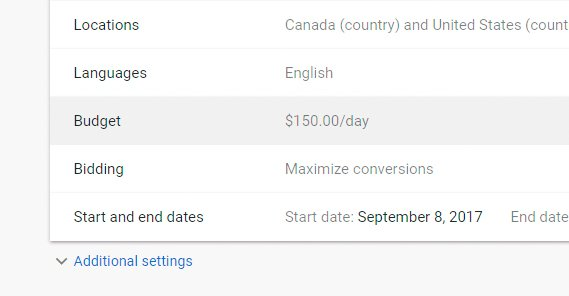
Daily Budget vs Shared Budget: Which to Choose?
To help you decide between Daily Budget and Shared Budget for your campaigns, here’s a comparison of their key features:
| Feature | Daily Budget | Shared Budget |
|---|---|---|
| Definition | Budget set for each individual campaign. | Budget shared across multiple campaigns. |
| Best for | Specific campaigns with unique goals. | Multiple campaigns with a goal. |
| Budget Control | Precise control over each campaign’s spending. | Flexible distribution based on performance. |
| Ease of Management | More time-consuming to manage multiple budgets. | Easier to manage fewer shared budgets. |
| Risk | Over-spending on high-performing campaigns. | Under-spending on low-performing campaigns. |
| Performance Optimization | Limited optimization per campaign. | Better optimization across campaigns. |
| Example Use Case | Seasonal promotions, or special events. | Brand awareness campaigns across regions. |
So, when to use each budget type?
Opt for a Daily Budget when you need precise control over individual campaigns with unique goals, such as seasonal promotions or special events. This approach ensures tight budget adherence without crossover.
Choose a Shared Budget for multiple campaigns with common objectives, like brand awareness. This method allows flexible fund distribution based on performance and simplifies management, optimizing overall spending.
How to Calculate Google Ads Budget?
I will compile the formulas and examples for clarity. Below, you’ll find a template where you can input your numbers for automatic calculations.
1. Average Daily Budget
Step 1: Determine the Average Daily Budget
Decide how much money you are willing to spend each day. This can be based on your overall monthly budget divided by the number of days you want your ads to run.
- Formula:
Average Daily Budget = Monthly Budget/30.4
Note: 30.4 is used as the average number of days per month.
- Example:
If your monthly budget is $1,500 and you want to run ads every day (30.4 days),
Average Daily Budget = 1500/30.4 ≈ $49.34/day
Step 2: Estimate Clicks per Day
Divide your daily budget by the estimated average CPC to determine how many clicks you can afford per day.
- Formula:
Estimated Clicks per Day = Average Daily Budget/Average CPC
- Example:
With a daily budget of $49.34 and an average CPC of $2,
Estimated Clicks per Day = 49.34/2 ≈ 24.67 clicks/day
2. Shared Budget
Step 1: Determine the Total Shared Budget
- Formula:
Total Shared Budget = Sum of Individual Campaign Budgets
- Example:
If you have 3 campaigns with daily budgets of $20, $30, and $50 respectively,
Total Shared Budget = 20 + 30 + 50 = $100/day
Step 2: Calculate the Monthly Shared Budget
- Formula:
Monthly Shared Budget = Total Shared Budget × 30.4
Note: 30.4 is used as the average number of days per month.
- Example:
With a total shared budget of $100 per day,
Monthly Shared Budget = 100 × 30.4 = $3040
How Much is the Minimum Google Ads Budget?
Based on my extensive experience in digital advertising, there is no fixed minimum budget for Google Ads. However, a practical starting point is at least $10 per day, totaling about $300 per month. This amount allows you to collect sufficient data for optimization.
In competitive industries like finance or legal, you may need $50-$100 per day to compete effectively, equating to $1,500-$3,000 per month. For small businesses or newcomers, a monthly budget of $500-$1,000 (approximately $16-$33 per day) is recommended to ensure your ads get enough visibility to drive meaningful engagement and conversions.
>>> Read more: How Much Does Google Ads Cost in 2024? Is It Worth Investing in?
Suggested Monthly Budget for Google Ads
To determine your best budget for Google Ads, start by allocating 5-10% of your annual revenue to marketing. For example, with an annual revenue of $500,000, this means $25,000-$50,000 for marketing. Typically, 20-50% of your marketing budget should go to Google Ads. So, if you allocate $50,000 annually to marketing, $10,000-$25,000 could be for Google Ads, translating to a monthly budget of $833-$2,083.
Consider industry benchmarks for cost-per-click (CPC). If your industry’s average CPC is $2 and you aim for 1,500 clicks per month, you need around $3,000 (1,500 clicks * $2 CPC). Adjust based on specific campaign goals and seasonal needs to optimize your budget effectively.
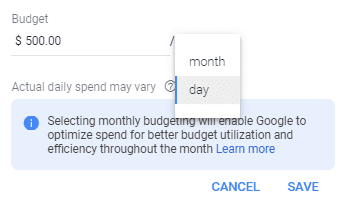
However, I’ve discovered some key guidelines based on the size of the business:
- For small and local businesses, the recommended Google Ads budget ranges from $1,500 to $8,000 per month.
- For mid-size businesses, a suggested ad spend is between $7,000 and $30,000 per month.
- For enterprise-level businesses, the advised ad spend is $20,000 to $50,000 per month.
In some cases, small businesses might spend up to $10,000 per month if they are performing well and need to scale. Similarly, enterprise-level organizations may end up investing as much as $80,000 on Google Ads.
How to Set Google Ads Budget?
I’ll describe each step in detail so you can follow along with your own dashboard.
Step 1: Log in and Select Campaign
Log in to Google Ads and navigate to the main dashboard.
Click “Campaigns”, select the campaign you want to set the budget for.
Click the “Settings” tab within the selected campaign.
Step 2: Set Your Budget
- Daily Budget:
- In the “Settings” section, find the “Budget” field.
- Enter your daily budget as you want. This is the amount you’re willing to spend per day on this campaign.

>>> Read more: Why Google Ads Daily Budget Overspend & How to Solve?
- Shared Budget:
- Go to the “Tools and Settings” menu (the wrench icon in the top right corner).
- Under the “Shared Library” section, click on “Shared Budgets”.
- Click the plus (+) button to create a new shared budget.
- Name your shared budget and enter the amount you want to share across multiple campaigns.
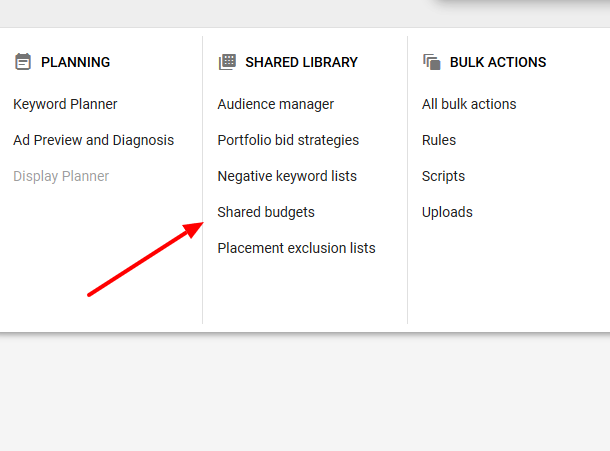
Step 3: Choose a Bidding Strategy
Under the “Bidding” section, select your bidding strategy based on your campaign goals (e.g., Manual CPC, Target CPA).
Adjust your bids to align with your daily or shared budget.
Step 4: Save Your Settings
Once you have set your budget and bidding strategy, click “Save” to apply the changes.
Strategies to Manage Budget and Reduce Advertising Costs
Managing your Google Ads budget effectively ensures that you get the most out of your advertising spend. Here are some strategies to help you manage your budget efficiently:
#1 Use Past Data to Forecast Future Ad Spend
- Collect historical data: Gather all relevant metrics such as daily or monthly ad spend, clicks, and conversions from your Google Ads account by exporting the data.
- Analyze the data: Identify trends and patterns, such as higher spending during specific months or consistently high-performing campaigns and keywords.
- Adjust your budget: Based on your forecast, modify your budget as necessary. Consider increasing it for new campaigns or market expansions.
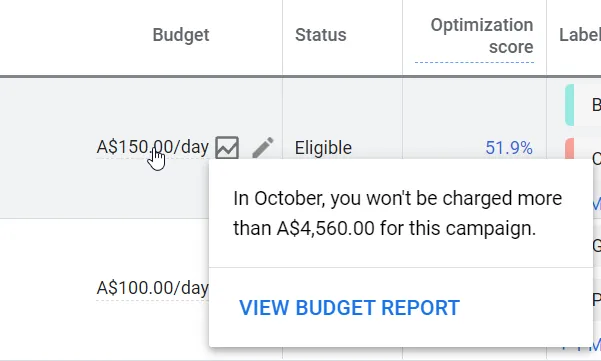
#2 Use Google Ads Budget Planner Tools
Currently, there are many tools available on the market that can help you create a Google Ads Budget Planner. By using these tools, you can input different budget scenarios and see detailed estimates on clicks, impressions, and conversions. This allows you to identify the most cost-effective budget level.
The tools also provides recommendations for budget adjustments, helping you allocate funds more efficiently. By leveraging these insights, you can reduce unnecessary spend and focus your budget on high-performing areas, ultimately lowering your overall advertising costs while maximizing your campaign’s effectiveness.
#3 Collaborate with a Google Ads Management Agency
Partner with a Google Ads Management Agency to benefit from their expertise and experience. An agency can help optimize your campaigns, manage your budget more effectively, and implement cost-saving strategies.
Partnering with Mega Digital, a Google Premier Partner, provides access to exclusive Google tools, including heatmaps and real-time market data. As the only agency in Asia with these privileges, we ensure your ad spend is optimized effectively to achieve your marketing goals.
When is The Time to Increase Google Ads Budget?
To evaluate whether you should increase your budget, we need to take a closer look at the specific metrics and columns in your Google Ads account.
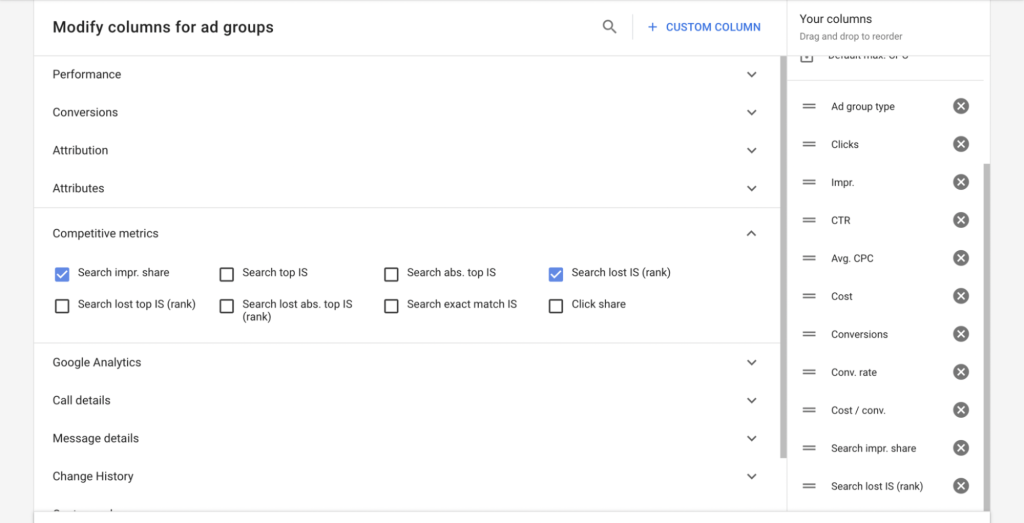
Enable the following four columns at the ad-group level of your campaign:
- Conv. rate: The conversion rate for each ad group.
- Cost/conv.: The average cost per conversion for each ad group.
- Search impr. share: The percentage of times your ads appear based on each ad group.
- Search lost IS (rank): The percentage of times your ads do not appear due to the rank of each ad group.
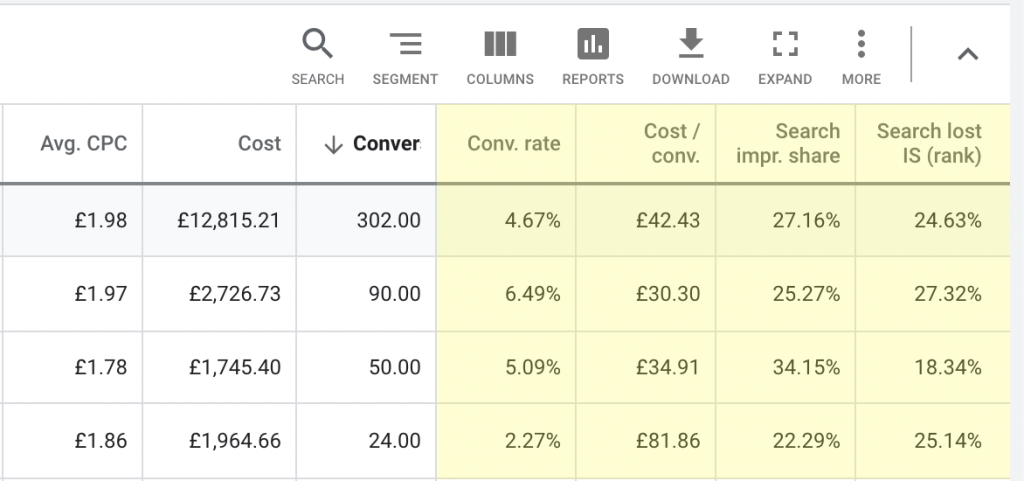
Now, if your conversion rate (1) and cost per conversion (2) are satisfactory in terms of returns, check your search impression share (3). If the search impression share (3) is low (e.g., under 10%) and the search lost IS (rank) is high, it indicates you should increase your budget.
This adjustment will allow you to maintain the same cost-per-click and cost-per-conversion but at a larger scale, as you will no longer be limited by a low budget.
>>> Read more: Google Ads Not Spending Budget: Why and How Can You Solve It?
Wrap up
Effectively managing your Google Ads budget is key to maximizing your ROAS and achieving your marketing goals. Use tools like the Google Ads Budget Planner and consider expert guidance to optimize your ad spend and drive the best results!
While optimizing your campaign settings is essential, sometimes external factors like disapprovals or payment holds can still restrict your ability to optimize your budget. In that case, renting a Google Ads agency account from Mega Digital can give you expert support and the ability to reallocate your unspent budget easily!







![Set up TikTok ads payment method in 5 steps [Agency walkthrough]](https://megadigital.ai/wp-content/uploads/2023/03/TikTok-Ads-Payment-Method.jpg)
